新政府正计划做出将影响租户和房东的变革。国家领导的联盟已承诺改变租赁的运作方式,这让投资者感到高兴,但租户代表却不高兴。
拟议的变更之一是允许房东在不给出理由的情况下终止租赁,前提是他们提前90天发出通知。这是对2020年法律变更的逆转。奥克兰房地产投资者协会总经理萨琳娜·吉本将其比作房东的 “保险单”。但是,Renters United的乔迪·罗杰斯认为,需要就房东为何需要无理由驱逐租户进行更成熟的讨论。
政府还计划将租户终止定期租赁的通知期从28天缩短至21天。此外,想要出售、翻新、重建或搬入房产的房东的通知期将从90天缩短至42天。Gibbon认为这是一个积极的变化,因为它可以帮助租户避免由于租赁日期不一致而支付双倍租金。
Act Party正在推动房东能够为潜在的宠物伤害收取额外租金。目前,房东不能要求超过四周的租金作为保证金。尽管吉本认为该提案需要更多细节,但罗杰斯认为没有必要。
出于税收目的,投资者将能够从租金收入中扣除住房贷款利息成本。尽管一些投资者认为这可能会限制未来的租金上涨,但罗杰斯怀疑这种救济能否转嫁给租户。另一方面,Gibbon认为这对投资者来说是一个显著的优势。
最后,政府计划将投资者为避开资本利得税而必须持有房产的时间从10年缩短至两年。有人认为,这可能会导致更多房产的出售,吉本认为这对投资者来说是一个积极的变化。





























































